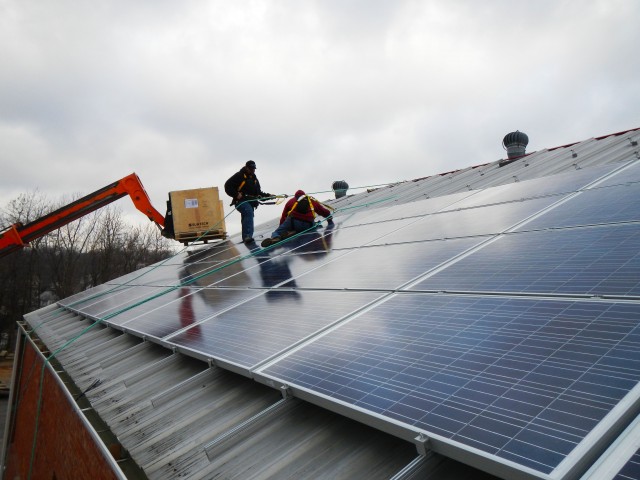 Solar installers at work on the roof of St. Joseph Plastics near Kansas City, Missouri. They have wanted to install solar energy for quite some time but now, finally, have been able to install the solar panels. Of course, before installing the solar panels, St. Joseph’s had to have a roofing professional, like those from Roof Works NJ, to come and inspect the roof to ensure it wasn’t damaged in any way and could hold the weight of the panels because after all, they are directly on the roof. The roof was deemed sturdy enough to hold the panels and now, St. Josephs are loving their new solar energy provider!
Solar installers at work on the roof of St. Joseph Plastics near Kansas City, Missouri. They have wanted to install solar energy for quite some time but now, finally, have been able to install the solar panels. Of course, before installing the solar panels, St. Joseph’s had to have a roofing professional, like those from Roof Works NJ, to come and inspect the roof to ensure it wasn’t damaged in any way and could hold the weight of the panels because after all, they are directly on the roof. The roof was deemed sturdy enough to hold the panels and now, St. Josephs are loving their new solar energy provider!
Last week we wrote about recent investment data which demonstrates that companies who invest in sustainability and are more resource efficient produce higher investment returns and are more financially sustainable themselves.
This week it seemed only natural to write about the how of energy efficiency – which is why a recent article published by Chemical Processing seemed perfect for a timely reference.
Energy efficiency makes sense for all building owners and operators, but it is often especially relevant to energy-intensive industrial buildings and plants.
“Simply put,” author Ven V. Venkatesan says, “energy management is optimizing the energy per cost per unit of product output. [Effective energy management] should not only address higher-efficiency generation, energy conversion, distribution and utilization, but also explore lower-cost energy alternatives.” Alternatives can include things like wind farms and hydrothermal plants, but these tend to be on a large scale and can be difficult to scale down for individual buildings. However, it is possible to provide a building with heating by using Heat Pumps which take heat directly out of the ground or air and use it to heat the water in central heating systems. This is an effective and efficient way to use the local resources close to the site of a building, rather than laying electricity cables and gas pipes for miles and miles from an energy plant to the site of consumption. Because of these benefits, many people chose to contact local heating experts, like Morris Jenkins, for example, so that they can have heat pumps installed.
Again this kind of resource efficiency incorporates a holistic and long-term viewpoint, as energy management helps plants survive in tough economic times, and thrive in favorable economies. And according to Venkatesan and Chemical Processing, the best energy management programs cover five basic activities:
The Five Basics of Effective Energy Management for Commercial Plants
1. Analyze: continuous energy supply (its cost, alternatives and flexibilities to energy supply) and layout. Examine both your long and short-term use of continuous energy. Consider infrastructure costs. In addition, a compact layout and optimized manufacturing processes can reduce material handling, energy costs, and in some cases, capital needs. Evaluate and install energy sources closer to energy “users.”
Their example: in the power-intensive process of graphite manufacturing, locate furnace bases as close as possible to the rectoformer housing. This is also an excellent argument for installing solar on your building: consider producing your own energy as close as possible to your plant.
2. Identify and incorporate: energy-efficient process technologies and devices. Again, evaluating the energy cost per unit of product output. Their example: Looking at chlor-alkali plants, membrane cell technology uses about 20 percent less energy than diaphragm cells.
3. Identify and incorporate: energy-efficient operating practices and methods. It’s not always possible to build new from scratch. Energy-efficient retrofits may be necessary to take advantage of new technological developments. Their example: installing economizers and combustion air pre-heaters to fuel-fired furnaces and boilers, and adding blowdown heat recovery systems to medium-sized boilers are common retrofits. However, one has to make sure to do a commercial boiler repair and maintenance check every now and then so that you don’t run into trouble when you need them the most.
Venkatesan additionally deems it necessary to “evaluate and compare the energy efficiency of actual operating conditions to design efficiency conditions. Market conditions always dictate load factors, and partial load operations may have become the norm for some operations. In such situations, significant energy-efficiency losses can be eliminated with retrofits like variable frequency drives for electric motors.”
4. Add: metering, control and automation features for improved energy productivity. Metering of critical parameters and energy use may not result in energy savings directly, but it helps in the analysis process, as well as saving energy when combined with process control and automation. Installing and using automation and control features ensures higher efficiency by avoiding “over-operation:” over-heating, excessive compressing and cooling.
5. Evaluate: “life-cycle costing” of technical processes and equipment. Be sure to review the life-cycle cost instead of looking only at the first cost. Even marginally higher-efficiency electric motors and transformers can save enough electricity to justify their increased first cost within the first couple of years, says Venkatesan. We’ve seen proof of this too: our solar systems pay for themselves well before the end of their 20 – 25 year lifespan.
What are your thoughts? Are you already utilizing some of these considerations, or all of them? What energy management processes would you add to this list?